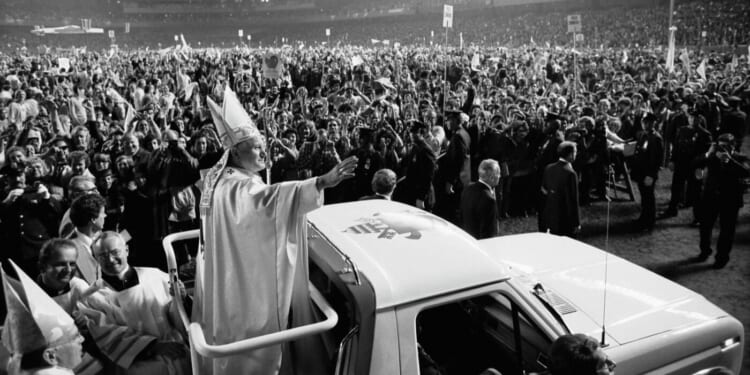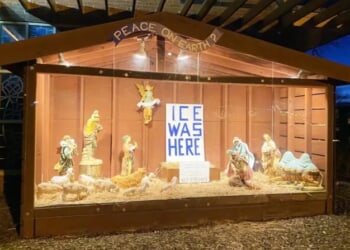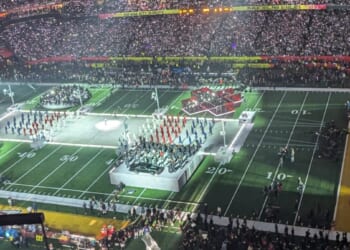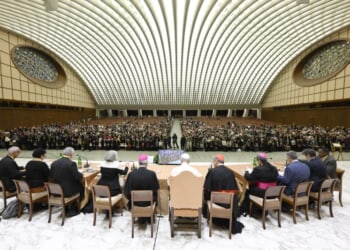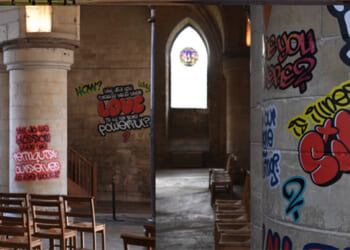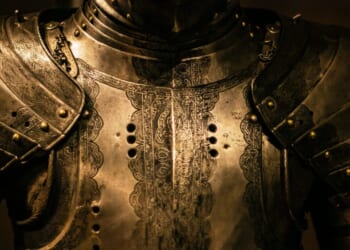I’ve lived long enough to see smoke rise from the Sistine Chapel five times. One of those times, working as a Latin secretary for Benedict and waiting to see who my next boss would be, I could even smell it.
Each conclave has been as exciting as the previous, but nothing will match the election of John Paul II in 1978. Never had anyone so young, so vigorous, so dynamic emerged on the balcony of St. Peter’s. I was only eight years old, but my world changed instantly. Suddenly, an accomplished athlete and actor was donning the white cassock; a Pole, a polyglot, a philosopher.
A year later, my family joined over a million people in Grant Park to celebrate Mass with him. John Paul was only the second pontiff to visit the United States, the first being Paul VI in 1965. The Windy City boasted a large Polish population, and, though Irish, I felt one with them as a Chicagoan, as did the Germans, Italians, African Americans, and Hispanics. We joined our voices that chilly fall morning to profess our faith in the One, Holy, Catholic, and Apostolic Church, together with the 265th successor of St. Peter.
Marveling at the throng, the young pope described us as:
…a people who have thrown their destinies together and now write a common history. Different as you are, you have come to accept each other, at times imperfectly and even to the point of subjecting each other to various forms of discrimination; at times only after a long period of misunderstanding and rejection; even now still growing in understanding and appreciation of each other’s differences.
That Liturgy drove me to amass a pile of comic books about the pope’s life: his work in the quarry, his studies in the underground seminary, his performances in the theatre. His skiing inspired me to learn the sport and fall in love with it.
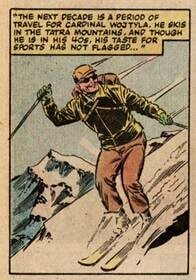
I still don’t know how I got my hands on Dives in Misericordia—much less how I understood it—but even as a ten-year-old, I knew I was reading something extraordinary. Rereading that 1980 Encyclical, together with his 1979 Redemptor Hominis, has convinced me that the “hypostatic union” is anything but an abstraction.
“The more the Church’s mission is centered upon man—the more it is, so to speak, anthropocentric—the more it must be confirmed and actualized theocentrically, that is to say, be directed in Jesus Christ to the Father” (Dives in Misericordia, 1). It was John Paul’s technical way of saying, “So you want to become more human and to know God? Meet Jesus Christ!”
Tears streamed down my face as I walked home from school on May 13th, 1981, after the school principal informed us that an assassin’s bullet had pierced his chest. It was too much to bear just two months after the attempt on the life of President Ronald Reagan.
I never dreamed I would have the opportunity to meet the saintly pontiff a dozen times or so through the years, most of those while studying in Rome. He never lost his sense of humor even as his health began to fail. I remember handing him a set of petitions from my home parish, the name “St. Anne’s Catholic Church” printed in large letters on the envelope so the photographers could capture it and I would have proof of its delivery. His Holiness knew perfectly well what I was up to and let out a chuckle as he slapped me across the face with the envelope.
The writings of John Paul II led me to philosophy, something I hardly imagined would one day earn me a meagre but decent salary studying, teaching, and writing. I continue to reread Fides et Ratio (1998) at least once a year, remembering how the title given it by my beloved Latin teacher, Fr. Reginald Foster, OCD—Alarum Duarum (“Of the two wings”)—was regrettably rejected.
Fortunately, the phrase still exists in the opening sentence:
Faith and reason are like two wings on which the human spirit rises to the contemplation of truth; and God has placed in the human heart a desire to know the truth—in a word, to know himself—so that, by knowing and loving God, men and women may also come to the fullness of truth about themselves (cf. Ex 33:18; Ps 27:8-9; 63:2-3; Jn 14:8; 1 Jn 3:2).
Announcing that message was, in a nutshell, the project of Pope St. John Paul II. Thanks to him, I’ve made it the project of my life too as a husband, father, teacher, and disciple. When one of those “two wings” tires or falters, I have the other to keep me aloft. If either were severed, my spirit would plummet, and the joy of contemplating the truth would run dry.
It’s amazing to think that, in the span of my lifetime, a man whose name no one could pronounce would one day be pronounced a saint.
John Paul changed my life in so many ways, but none more important than the devotion to Our Lady he taught me. I grew up in an era of post-conciliar confusion when the Church was marginalizing Mary’s role not only in spirituality, but in salvation history. By choosing the motto Totus Tuus, John Paul reminded the Church that acknowledging the Virgin’s role in salvation history and imitating her love for Jesus in no way marginalizes Christ from our own lives. It only places Him back at the center.
Commenting on John 3:16 (“God so loved the world that he gave his only Son”), John Paul II wrote that “at the center of this mystery, in the midst of this wonderment of faith, stands Mary. As the loving Mother of the Redeemer, she was the first to experience it: ‘To the wonderment of nature you bore your Creator!’” (Redemptoris Mater, 51).
He now joins her in praising his Creator, hers, and ours. Every October 22nd, I take great consolation in the intercession of both.
Pope St. John Paul II, pray for us!
Image from Wikimedia Commons

